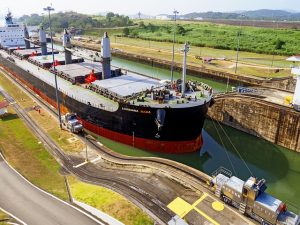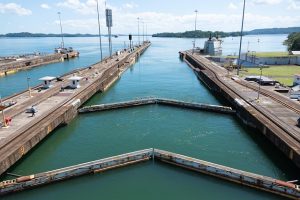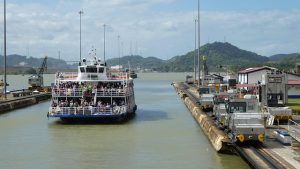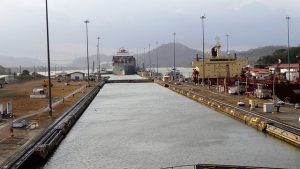パナマ運河は誰のもの?アメリカorパナマ 運営主体が二転三転?

パナマ運河は誰のもの?アメリカor パナマ 運営主体が二転三転?
トランプ大統領の取り組みは?
私の記憶にある昭和のパナマ運河
私は 1950年代 田舎の教師の家で生まれ幼い頃は
山や田んぼ、畑を走り回っていました。
しかし、1学年下の児童に少し変わった職業のお父さんがいました。
そのお父さんの職業は 船員さん 貨物船の機関士として
当時 海運王国・日本のシンボルとして七つの海を航海していました。
時々、お話を聞くと、太平洋の荒波は本当に大変で、転覆しかけた事もあるとの事。
また、初めてパナマ運河は通過した時は、すべてが初めての事ばかりで驚いたとも!
そして、運河の完成で、「太平洋と大西洋の行き来が本当に楽になった」とも
話していたのを覚えています。
それまでは、場合により南米の先端を回っていたので~。
私は、外国船の航路も分かりませんが、パナマ運河が船乗りにとって
非常に楽になったのを感じました。

パナマ運河の歴史とトランプ大統領の取り組みとは?
中南米に位置するパナマ共和国。その小さな国土に建設された
「パナマ運河」は、世界の物流を根底から変えた“海の大動脈”です。
この運河は、太平洋と大西洋を最短距離で結ぶという壮大な構想のもと、
20世紀初頭にアメリカによって完成しました。
パナマ運河の誕生とその後の歴史、そして21世紀における
トランプ大統領の関与までを振り返ります。
パナマ運河の誕生とその意義!
パナマ運河は1914年、アメリカの主導によって完成しました。
建設当初の目的は、南米大陸の最南端をぐるりと回る
マゼラン海峡航路に代わる「時間短縮・コスト削減」のためのルート確保でした。
軍事的にも商業的にも極めて重要な拠点であったため、
当時のアメリカにとって戦略的価値は絶大でした。
工事は技術的困難とマラリア・黄熱病などの病気との闘いでもあり、
数万人の労働者が命を落としたとも言われています。
それでも完成した運河は、国際物流の要として現在まで使われ続けています。

アメリカからパナマへの運河返還!
1977年、アメリカとパナマは「トリホス・カーター条約」に調印し、
1999年12月31日をもって運河の運営権を正式にパナマに返還することが決まりました。
この返還は、長年の独立運動や主権回復のシンボルとして、
パナマ国民にとって大きな意義を持つものでした。
2000年代以降は、パナマ政府による運営が続いており、
2007年には大型船の通行に対応した拡張工事がスタート。
2016年には新パナマ運河が開通し、中国をはじめとするアジア諸国との
物流がさらに強化されました。
トランプ政権とパナマ運河への視線!
ドナルド・トランプ大統領1期目(在任期間:2017年~2021年)は
「アメリカ第一主義」を掲げ、経済的・軍事的にアメリカの国益を
最優先する外交政策を展開しました。
2期目の現在はさらに強化している様にも見えます。
現実的、直接的にパナマ運河そのものの管理に関与したわけではありませんが、
以下のような観点から運河への影響があったと考えられます。
- 中国の影響力拡大への懸念
トランプ政権下では、中国の「一帯一路」構想や中南米における
インフラ投資が安全保障上の懸念として議論されました。
パナマ運河周辺でも、中国企業が港湾施設の運営に関与するケースが増加しており、
これに対してアメリカは警戒感を示していました。
トランプ氏の発言や外交姿勢には、こうした地政学的懸念が色濃く反映されていました。
- 米国と中南米の関係強化政策
トランプ政権は中南米諸国との貿易・外交関係を見直す一方で、
移民や麻薬問題への対応を重視しました。
パナマもその戦略の一部と見なされ、
トランプ氏は幾度かパナマ大統領と会談を行い、地域の安定と経済協力の
必要性を強調しました。
今後の展望!
グローバル物流と安全保障の交差点
パナマ運河は今も世界貿易の約6%を担う重要航路です。
アメリカ、中国、ヨーロッパ諸国が交錯するこの「海の交差点」は、
今後も国際政治と経済の複雑な駆け引きの舞台であり続けるでしょう。
トランプ大統領が残した“アメリカ第一”の路線は、今もアメリカ政治の根底にあり、
それはパナマ運河周辺の地政学的バランスにも少なからず影響を与えています。

まとめ
パナマ運河は単なる運河ではありません。
それは100年以上にわたる国際協調と対立の歴史の象徴であり、
今も世界の動きを映し出す鏡です。
トランプ大統領の取り組みを通して見えてくるのは、
パナマ運河がいかに戦略的に重要な存在であり続けているかという事実です。

Who Owns the Panama Canal?
Shifts in Its Administration and Trump’s Involvement
My Memories of the Panama Canal in the Showa Era
I was born in the 1950s in a rural teacher’s household,
and as a child I spent my days running around the mountains,
rice fields, and vegetable patches.
One grade below me, there was a student whose father had
a rather unusual job.
He was a seaman—a chief engineer on a cargo ship—who,
at the time, sailed the seven seas as a symbol of
Japan’s maritime prowess.
Whenever I heard his stories,
I learned that the rough waves of the Pacific
were truly formidable;
he had even come close to capsizing.
He also told me that the first time
he passed through the Panama Canal,
everything about it was new and surprising.
He recalled how the canal’s completion
had made traveling between the Pacific and Atlantic Oceans much easier.
Before that, ships sometimes had to sail
all the way around the tip of South America.
Though I had no knowledge of foreign shipping routes,
I could sense how greatly the canal had eased the lives of sailors.

The History of the Panama Canal and Trump’s Involvement
Situated in Central America,
the Republic of Panama is home to the Panama Canal,
a “maritime artery” that has transformed global logistics from the ground up.
This canal, designed to connect the Pacific and Atlantic Oceans by the shortest route,
was completed in the early 20th century under the leadership of the United States.
Let us look back on the birth of the Panama Canal,
its subsequent history, and former President Donald Trump’s connection to it in the 21st century.
The Birth and Significance of the Panama Canal
The Panama Canal was completed in 1914 under U.S. leadership.
Its original purpose was to provide a faster and
more cost-effective route than sailing around the Strait of Magellan
at the southern tip of South America.
Strategically, it was of immense military
and commercial value to the United States at the time.
Construction was fraught with technical difficulties and
the deadly threats of malaria and yellow fever—
tens of thousands of workers are said to have lost their lives.
Nevertheless, the canal has continued to serve as
a key hub of international trade up to the present day.

The Return of the Canal from the U.S. to Panama
In 1977, the United States and Panama signed
the Torrijos–Carter Treaties,
under which control of the canal was officially transferred to
Panama on December 31, 1999.
For the people of Panama,
this was a powerful symbol of their long struggle for independence and
the restoration of sovereignty.
Since the 2000s,
the canal has been operated by the Panamanian government.
In 2007, expansion work began to accommodate larger vessels,
and by 2016 the new Panama Canal was opened,
strengthening logistics links with China and other Asian countries.
The Trump Administration’s View on the Panama Canal
During Donald Trump’s first term as president (2017–2021),
he advanced an “America First” policy,
prioritizing U.S. economic and military interests in foreign policy.
In his current second term, this stance appears to have been further reinforced.
While he did not directly manage the Panama Canal itself,
his administration’s policies had indirect implications for
it in two main ways:
- Concerns Over China’s Growing Influence
Under Trump, China’s Belt and Road Initiative and
its infrastructure investments in Latin America were increasingly viewed
as security concerns.
Around the Panama Canal, there were growing cases of Chinese companies
operating port facilities—something the U.S. watched closely.
Trump’s statements and diplomatic posture reflected these geopolitical concerns. - Strengthening Relations Between the U.S. and Latin America
The Trump administration reviewed trade and diplomatic ties with
Latin American nations while placing emphasis on immigration and
drug-related issues.
Panama was considered part of this strategic framework,
and Trump met with the Panamanian president on several occasions,
stressing the need for regional stability and economic cooperation.
Future Outlook:
At the Crossroads of Global Trade and Security
Today, the Panama Canal still handles about 6% of global trade.
This “maritime crossroads,” where the interests of the United States,
China, and European nations converge,
will continue to be a stage for complex maneuvering
in international politics and economics.
The “America First” approach championed by Trump
remains a core element of U.S. politics,
influencing the geopolitical balance around the Panama Canal.

Conclusion
The Panama Canal is far more than just a waterway.
It is a symbol of more than a century of both international cooperation and conflict,
and it continues to reflect the movements of the world.
Viewed through the lens of Trump’s policies,
we see clearly that the canal remains a strategically vital asset—
its importance undiminished in the shifting tides of global affairs.
If you like, I can also prepare a polished,
magazine-style version of this English translation
so it reads like an international affairs feature article.
That would make it even more engaging for a blog audience.

